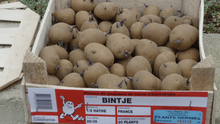Bintje
Bintje is a middle-early ripening potato variety bred in the Netherlands by the Frisian schoolmaster K.L. de Vries in 1904 from (Munstersen x Fransen) and marketed for the first time in 1910.[1] The name of the potato, a diminutive of Benedict, was borrowed from one of his former students.[2]
| Potato 'Bintje' | |
|---|---|
 'Bintje' potatoes | |
| Genus | solanum |
| Species | Solanum tuberosum |
| Hybrid parentage | 'Munstersen' x 'Fransen' |
| Cultivar | 'Bintje' |
| Breeder | K.L. de Vries, 1904 |
| Origin | Netherlands |

'Bintje' plants are medium-sized and erect, with purplish stems, dark green leaves and white flowers.
'Bintje' produces large oval-shaped tubers with pale yellow skin and yellow flesh. It has shallow eyes. The sprouts are purplish.
This high yielding variety is widely grown in Europe and North Africa. It is used for boiling, baking, and for French fries, mashed potato and potato chips. It is the most widely cultivated potato in France and Belgium.
'Bintje' is immune to Potato virus A. It has moderate resistance to Potato leafroll virus. It is susceptible to netted scab,[3] common scab,[3] Fusarium dry rot (Fusarium oxysporum), potato wart (Synchytrium endobioticum), Potato virus X, Potato virus Y, and late blight (Phytophthora infestans). 'Bintje' is sterile, which prevents improvements in disease resistance through breeding. A mechanism to overcome sterility has recently allowed for breeding-based genetic improvements in disease resistance and potato tuber coloration.[4]
It was voted "potato of the year 2012".[5]
Lieuwes Kornelis de Vries
Lieuwes Kornelis de Vries was born on February 25, 1854 in Hardegarijp. In 1881 he married Grietje Hommes de Jong. From this marriage six children were born. After the death of his first wife (1895) he married Afke Glee in 1897. From this marriage two children were born. De Vries died on November 20, 1929.
De Vries worked until he was 21 on the farm and then went to study for a teaching degree. In 1883 he became the head teacher at the primary school of Sumar. In 1894 he took the agricultural instrument test and in 1901 obtained a horticulture degree. Besides his work as a schoolmaster he gave agricultural winter courses. De Vries was a member of the Frisian Society of Agriculture. In 1898 the Society asked him to organize a testing ground for growing potatoes, which he managed for 25 years. He grew in twenty-five years about 150 varieties, of which only the Bintje was a success. The Bintje has been the most important potato on Dutch menus for a long time.
References
- Walker, Thomas S. "Patterns and Implications of Varietal Change in Potatoes". Social Sciences Working Paper (1994–3): 28–29. ISSN 0256-8748. Retrieved 22 July 2014.
- "Bintje (aardappelsoort (ras van Solanum tuberosum))" [Bintje (potato variety (cultivar of Solanum tuberosum))]. Etymologiebank (in Dutch). Retrieved 22 July 2014.
- Bouchek-Mechiche, K.; Gardan, L.; Normand, P.; Jouan, B. (1 January 2000). "DNA relatedness among strains of Streptomyces pathogenic to potato in France: description of three new species, S. europaeiscabiei sp. nov. and S. stelliscabiei sp. nov. associated with common scab, and S. reticuliscabiei sp. nov. associated with netted scab". International Journal of Systematic and Evolutionary Microbiology. 50 (1): 91–9. doi:10.1099/00207713-50-1-91. PMID 10826791. Retrieved 22 July 2014.
- Jones, Richard; Perez, Frances (2016). "A cellulose binding domain protein restores female fertility when expressed in transgenic Bintje potato". BMC Research Notes. 9: 176. doi:10.1186/s13104-016-1978-6. PMC 4797225. PMID 26992694.
- "Nicola is the "potato of the year" 2016". freshplaza.com. Archived from the original on 3 January 2017. Retrieved 2 January 2017.